Choose and plant only the best and most productive varieties of cucumbers.
| Content:
|
One of the criteria that vegetable growers follow when choosing cucumber seeds is the method of fertilization of the ovaries: bee-pollinated or self-pollinated.
But in the State Register of cucumbers there is no definition of “self-pollinating”, only parthenocarpic and bee-pollinated varieties and hybrids. And this is not surprising, since the familiar, and understandable to many, word “self-pollinating” is not applicable to cucumbers and implies the same parthenocarpic hybrids.
These hybrids are the result of breeding work. They are intended for closed greenhouses and areas where bees do not fly. All flowers in parthenocarpics develop into fruits without the participation of insects.
Description and features of parthenocarpics
The fruits of parthenocarpic cucumbers have a number of advantages:
- excellent taste, without bitterness;
- identical shape and size of greens;
- high yield, large number of ovaries;
- long-term storage;
- tolerate transportation well;
- form fruits in any weather without pollination;
- lack of seeds in ripe cucumbers;
- immunity to common cucumber diseases.
Such cucumbers are indispensable for growing in protected soil conditions - a greenhouse, balcony or window sill.
Fruits that are formed with parthenocarpy have no seeds or contain seeds without embryos. Therefore, in order to plant the same variety next year, you need to purchase seeds again. They cannot be obtained from your own harvest, as is the case with bee-pollinated cucumbers.
Based on all these characteristics, the seeds of paternocarpics have a higher price than the seeds of bee-pollinated cucumbers.
For growing cucumbers in open ground, it is preferable to grow varieties and hybrids that are pollinated by insects. The fact is that parthenocarpic cucumbers in open ground with temperature fluctuations can form curved, irregularly shaped fruits.
Varieties of self-pollinating cucumbers for greenhouses
Zozulya F1
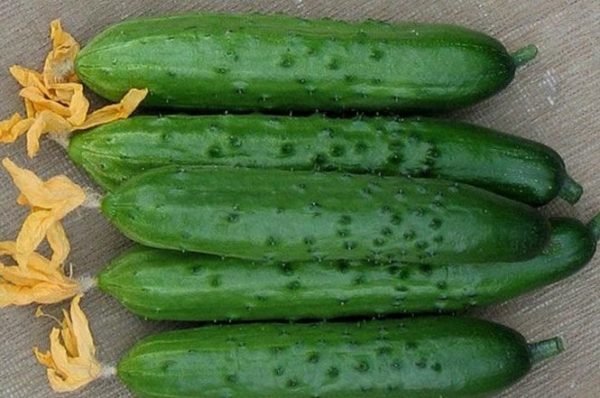
Zozulya F1
- parthenocarpic hybrid, early ripening;
- the first cucumbers will appear 46-48 days after germination;
- productivity - 15.6-24.9 kg/m;
- for cultivation in the Russian Federation in greenhouses;
- fruit length 14-23 cm;
- fruit weight - 120-150 g;
- resistant to a range of diseases;
- The fruits are good fresh and salted.
Sergey Nikolaevich
Zozulya F1 is the number 1 cucumber for greenhouses. I really love growing it. I really like the taste. Especially after salting. Lightly salted cucumbers turn out so tasty.
Alexander F1
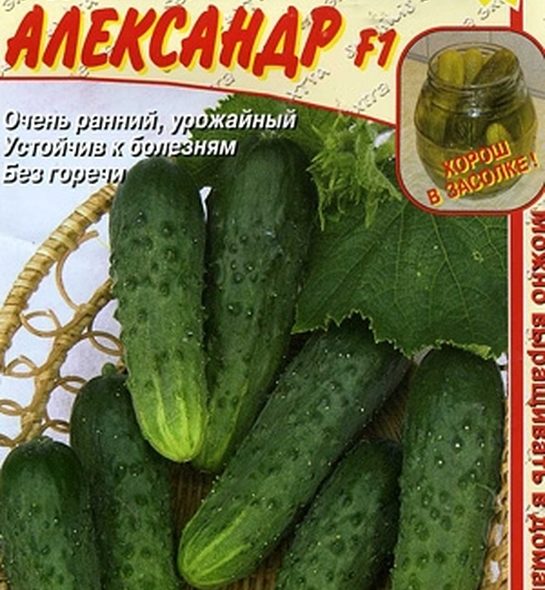
Alexander F1
- parthenocarpic hybrid, early ripening;
- the first cucumbers will appear 47 days after germination;
- yield 10.4 kg/m;
- for cultivation in the Russian Federation in greenhouses;
- short-fruited;
- fruit weight 140 g;
- resistant to a range of diseases;
- used fresh and for preparations.
Alyonushka F1
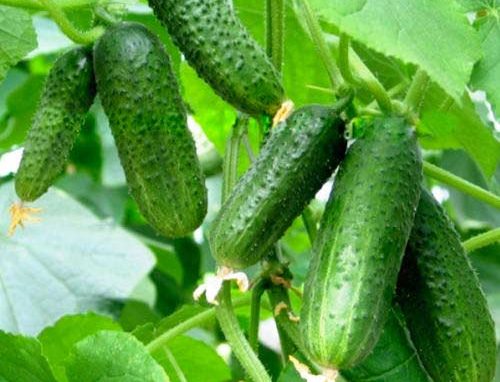
Alenka F1
- parthenocarpic hybrid, medium ripening;
- the first cucumbers will appear 51 days after germination;
- yield 11.4 kg/m;
- cultivation in closed ground in the Russian Federation;
- short-fruited;
- fruit weight 90 g;
- resistant to a range of diseases;
- universal application.
Arbat F1
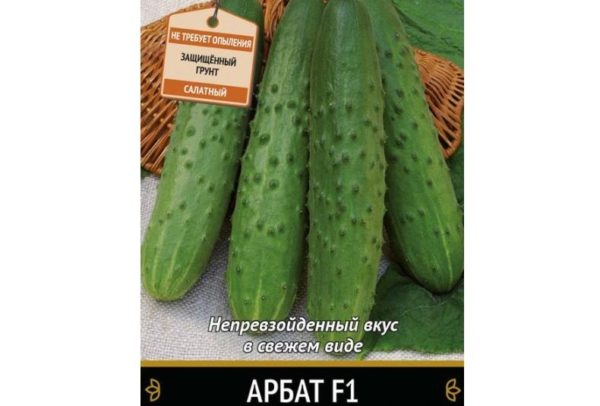
Arbat F1
- parthenocarpic hybrid, early ripening;
- the first cucumbers will appear 42-48 days after germination;
- yield 10.6 kg/m;
- cultivation in the Russian Federation is recommended only in greenhouses;
- fruit length 17-20 cm;
- fruit weight 180-200 g;
- resistant to cucumber mosaic virus, cladosporiosis;
- intended for fresh consumption and canning;
Babayka F1
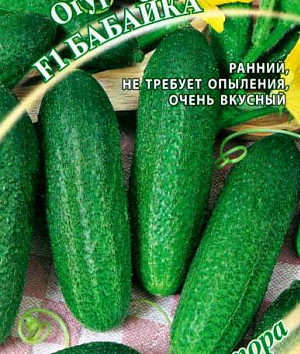
Babajka F1
- parthenocarpic hybrid, early ripening;
- the first cucumbers will appear 42 days after germination;
- yield 11.3 kg/m;
- recommended for cultivation in greenhouses throughout the Russian Federation;
- short-fruited;
- fruit weight 116 g;
- resistant to cladosporiosis, powdery mildew;
- purpose: salad, canning.
The hybrid is characterized by weak branching and a tendency to form determinate shoots.
Grandmother's grandson F1
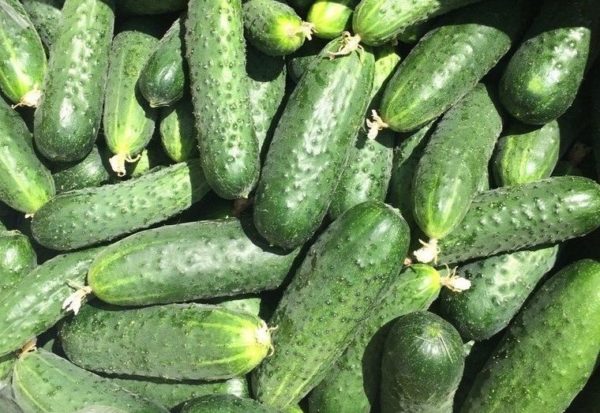
Babushkin vnuchok F1
- parthenocarpic hybrid, early ripening;
- the first cucumbers will appear 47 days after germination;
- yield 14.7 kg/m;
- for cultivation in greenhouses in the Russian Federation;
- short-fruited;
- fruit weight 125-145 g;
- resistant to cladosporiosis, powdery mildew;
- used fresh.
The taste is good and excellent.
Vladimir, Kursk
This is not the first year I have been planting. I like that I collect several kilograms from each bush. During the season I am fully supplied with cucumbers. They have a pleasant taste and no bitterness at all. I have never encountered any illness.
Pinocchio F1
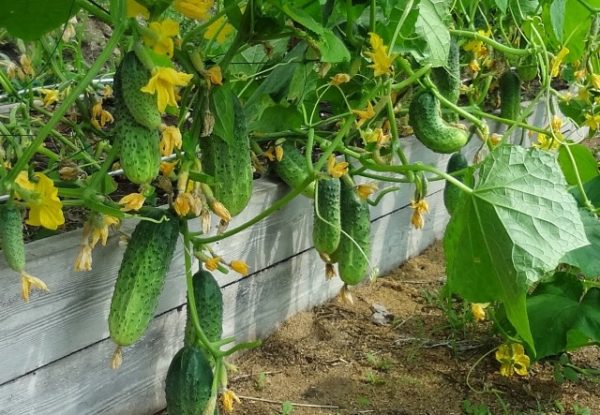
Buratino F1
- parthenocarpic, early ripening;
- the first harvest will appear 43-47 days after germination;
- yield 13.5 kg/m;
- for growing in greenhouses;
- short-fruited;
- fruit weight 85-120 g;
- resistance to cladosporiosis, powdery mildew;
- purpose: salad, canning.
Bourgeois F1
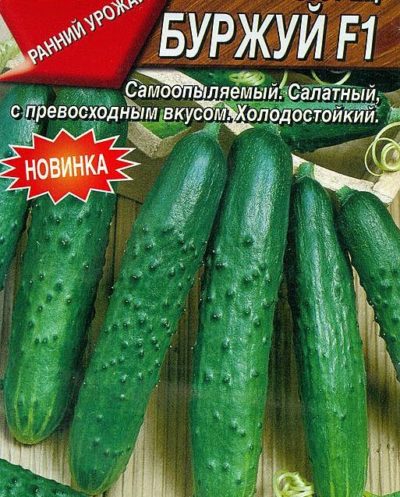
Burzhuj F1
- parthenocarpic, early ripening;
- the first crop can be harvested 44 days after germination;
- yield 15.5-16.0 kg/m;
- for growing in greenhouses;
- fruits of medium length;
- fruit weight 160-165 g;
- resistance to a complex of diseases;
- for fresh consumption.
Bjorn F1

B'ern F1
- parthenocarpic hybrid, early ripening;
- the first harvest will appear 43 days after germination;
- yield 13.4 kg/m;
- for cultivation in greenhouses in the Russian Federation;
- short-fruited;
- fruit weight 100 g;
- resistance to powdery mildew;
- Purpose: salad, canning, pickling.
Dina, 35 years old, Kaluga region.
Despite the fact that parthenocarpics seem to be intended for greenhouses, we tried to plant Bjorn cucumbers in open ground. We prepared the seedlings at home; the seeds were not soaked, but sown dry, one at a time, in plastic cups. They all sprouted within 2-3 days. When transplanting into the garden bed, I noticed how powerful the roots were. ... bouquet ovaries immediately began to form on them, and cucumbers began to pour one after another. You need to collect at least every other day so as not to overload the plant. Picked cucumbers are perfectly stored in the refrigerator or cellar. Very tasty, aromatic, dense and homogeneous inside with small seeds. Suitable for pickling and marinade.
Grandfather's granddaughter F1
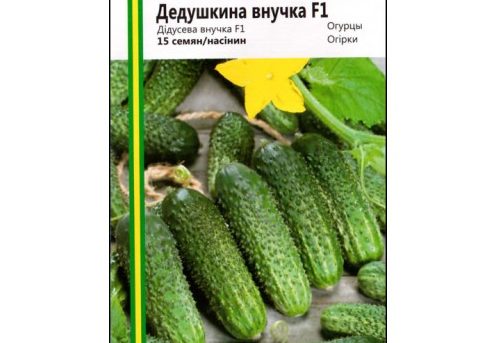
Dedushkina vnuchka F1
- parthenocarpic hybrid, early ripening;
- the beginning of fruiting - 43 days after emergence;
- yield 12.9-13.8 kg/m;
- for growing in greenhouses;
- short-fruited;
- fruit weight 130-150 g;
- high resistance to a range of diseases;
- Purpose: salad and canning.
Emelya F1
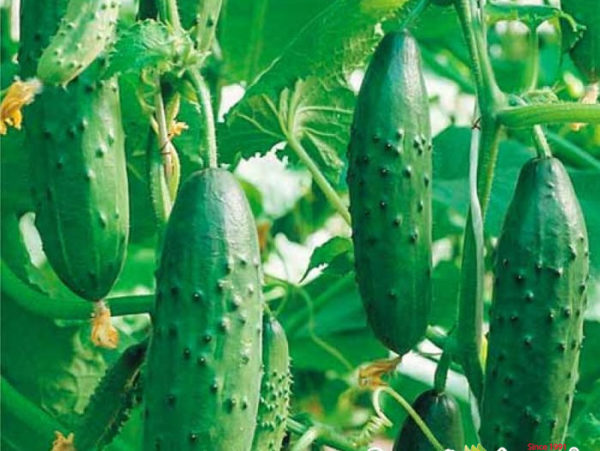
Emelya F1
- parthenocarpic, early ripening;
- The collection of the first fruits begins 39-43 days after germination;
- yield 12-16 kg/m;
- for growing in greenhouses;
- fruit length 13-15 cm;
- fruit weight 120-150 g;
- high resistance to a range of diseases;
- for fresh use.
Connie F1
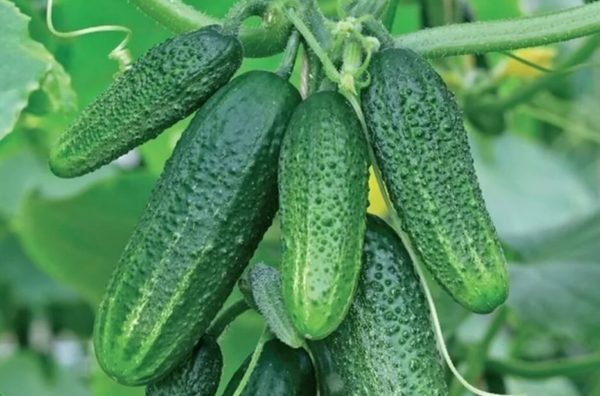
Konni F1
- parthenocarpic hybrid, early ripening;
- harvesting is possible 47-50 days after germination;
- productivity - 2.8-16.0 kg/m;
- for growing indoors;
- fruit length 7-9 cm;
- fruit weight 60-82 g;
- not susceptible to powdery mildew and root rot;
- universal use.
The value of the hybrid: early ripeness, bunched ovaries, short fruit, high marketability and taste of the fruit.
Tamara Vladimirovna, Voronezh
I would like to talk about the advantages of the self-pollinating cucumber variety Connie F1. Showed excellent germination: almost all seeds sprouted. The plants grew strong and healthy. The harvest is decent. Easy to care for. However, no one canceled all the required procedures: watering, fertilizing. The fruits are externally beautiful, compact, no more than 9 cm in length. There is absolutely no bitterness. Good fresh and prepared. I recommend trying this variety!
Hummingbird F1
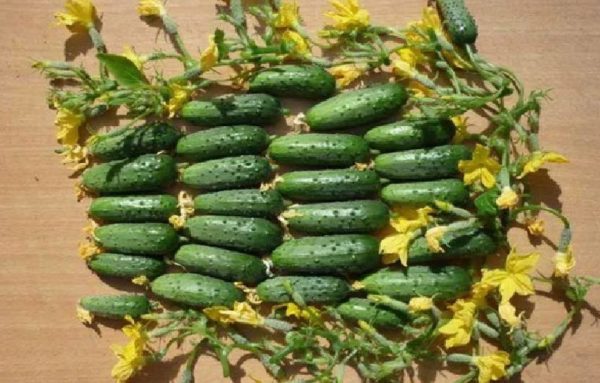
Kolibri F1
- parthenocarpic, early ripening;
- Harvesting begins 47-50 days after germination;
- yield 11-13 kg/m;
- for cultivation in the Russian Federation in greenhouses;
- short-fruited;
- fruit weight 60-82 g;
- resistant to cladosporiosis, viral cucumber mosaic, powdery mildew;
- universal use.
In the leaf axil, mainly 4-5 ovaries are formed.
Ant F1
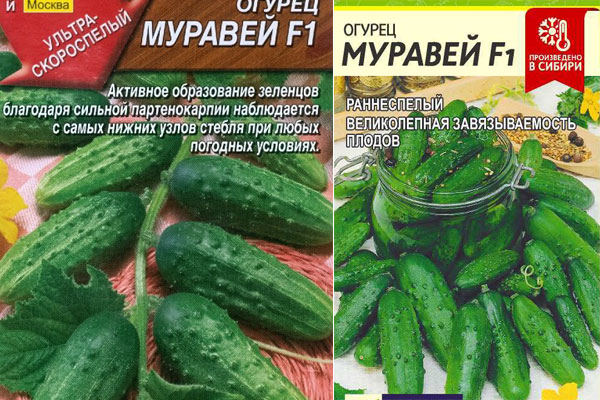
Muravej F1
- parthenocarpic hybrid, early ripening;
- The first fruits can be collected 37-38 days after germination;
- yield 10-12 kg/m;
- for cultivation in the Russian Federation in greenhouses;
- fruit length 8-11 cm;
- fruit weight 100-110 g;
- resistant to most cucumber diseases;
- universal purpose.
V.S. Butor.
“When I was first advised to take Ant seeds, I considered it a waste of time.I don’t trust hybrids; I prefer my own, home-grown varieties. But having tried to plant “Ant”, I left the principle aside. In addition to the fact that this variety can be grown at any time of the year, the harvest is also rich. Self-pollination is especially pleasing, because there are fewer and fewer bees every year.”
Parthenocarpic hybrids of cucumbers for growing in open ground
String bag F1
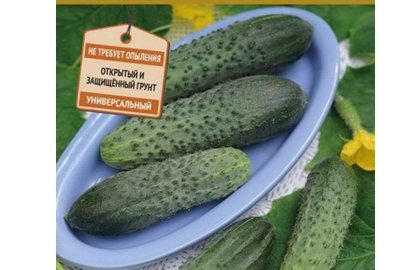
String bag F1
- parthenocarpic hybrid, early ripening;
- the beginning of fruiting - 39 days after germination;
- yield 13.3 kg/m;
- recommended for cultivation in greenhouses and open ground in the Russian Federation;
- short-fruited;
- fruit weight 115-145 g;
- not susceptible to complex cucumber diseases;
- universal purpose.
Balcony miracle F1
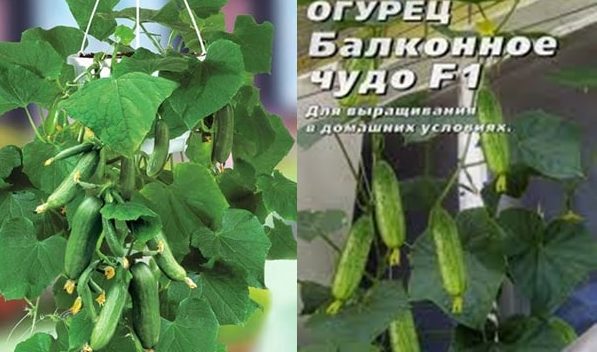
Balcony miracle F1
- parthenocarpic, early ripening;
- the first harvest will appear 40 days after germination;
- yield 14.5 kg/m;
- for cultivation in the Russian Federation in greenhouses and open ground;
- fruits 8-10 cm long;
- fruit weight 70-80 g;
- not susceptible to powdery mildew;
- universal purpose.
Paratunka F1
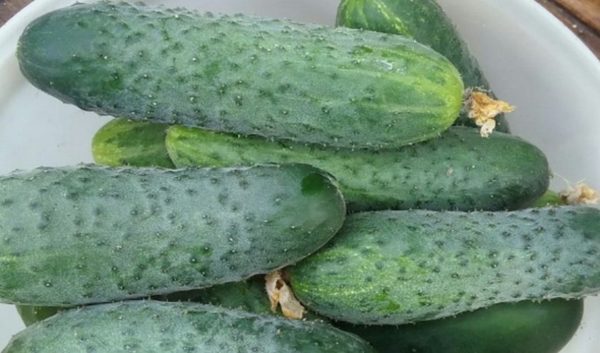
Paratunka F1
- parthenocarpic hybrid, early ripening;
- the beginning of fruiting - 42 days after germination;
- yield 12.7 kg/m;
- for cultivation in the Russian Federation in film greenhouses and open ground;
- short-fruited;
- fruit weight 75-100 g;
- resistant to cladosporiosis, powdery mildew;
- used fresh and for canning.
Zori Tatarstan
For the third year in a row I will be planting cucumber varieties Paratunka and Temp. Both F1. I like the taste, sweet without bitterness, early ripening, fruitful. I plant 4 pieces in the greenhouse. I also plant a little more soil. They are also good when pickled.
Barin F1
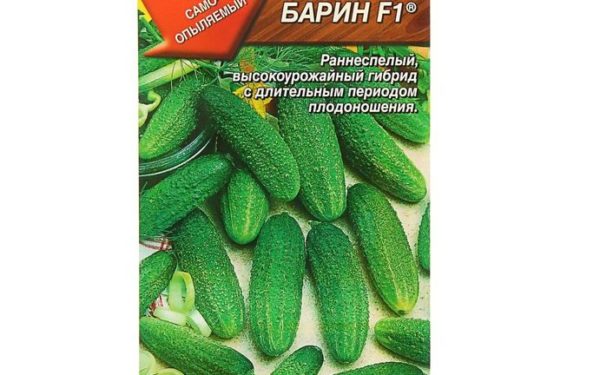
Barin F1
- parthenocarpic, early ripening;
- the first cucumbers will appear 42 days after germination;
- productivity in film greenhouses is 17.5 kg/m, in open ground 7.6 kg/m;
- for cultivation in the Russian Federation in greenhouses and open ground;
- short-fruited;
- fruit weight 108-142 g;
- resistance to powdery mildew, viral cucumber mosaic and root rot;
- for universal use.
Country Ambassador F1
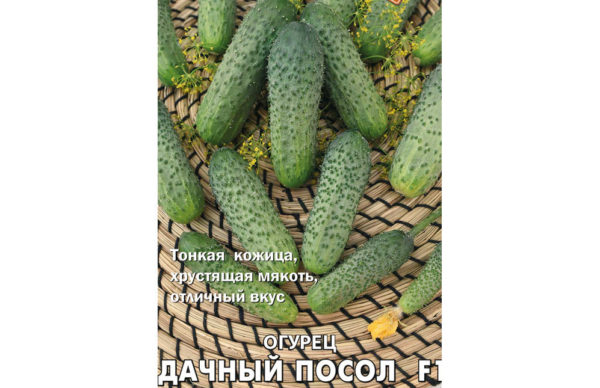
Dachnyj posol F1
- parthenocarpic hybrid, early ripening;
- the beginning of fruiting - 40 days after emergence;
- yield 14.5 kg/m;
- for cultivation in the Russian Federation in closed and open ground;
- short-fruited;
- fruit weight 90-120 g;
- high resistance to most cucumber diseases;
- used fresh and for canning.
City cucumber F1
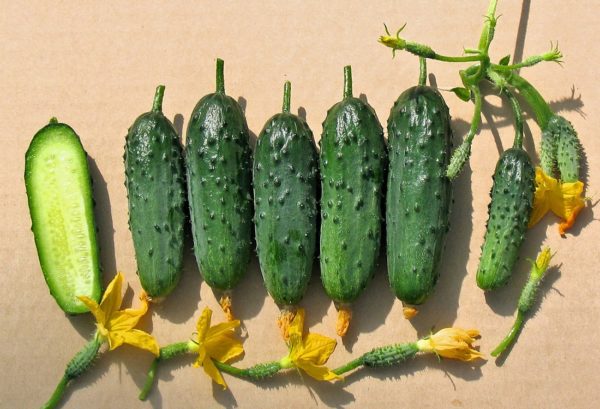
Gorodskoj ogurchik F1
- parthenocarpic hybrid, early ripening;
- the beginning of fruiting - 40 days after germination;
- yield 11.5 kg/m;
- for cultivation in film greenhouses and open ground in the Russian Federation;
- short-fruited;
- fruit weight 82 g;
- resistant to cladosporiosis, viral cucumber mosaic, powdery mildew;
- universal use.
Features of growing parthenocarpic cucumbers
Since there are no barren flowers on parthenocarpics, and greens are formed only on the central stem, the plants are formed in a certain way.
- removal of flowers and ovaries in the axils of the first 5 leaves;
- up to 50 cm of the central stem, pinch shoots into 1 ovary and 2 leaves (length about 25 cm);
- from 50 cm to 1.5 m, leave 2 ovaries and 2-3 leaves (length 35-40 cm);
- above 1.5 m, leave 4 ovaries and 3-4 leaves (length 45-50 cm);
- The central shoot is pinched at the height of the trellis (length about 2 m).
If plants are not formed, then most of the nutrients are spent on the formation of new vines and ovaries, while the ripening of fruits slows down, and the quantity and quality of the harvest decreases.
Otherwise, caring for so-called “self-pollinating” cucumbers is no different from caring for ordinary cucumbers pollinated by insects.
Reviews from gardeners
Irina Kozlova
The beginning of April is the best time to plant greenhouse cucumbers in the country. Productivity depends on many things. Even on the age of the seeds. It's better if they are over 3 years old. Parthenocarpic varieties are generally a win-win. From my own experience, I will name those that did not let me down: “Green Stream”. Secures up to 30 cucumbers on a bush. “Crispy Cellar”, “Zyatek”, “Herman”. They are all early and can be planted at intervals to ensure a constant supply of cucumbers.
dart777
“Choose a variety based on where the cucumbers are needed. Some are for pickling or pickling, others are for salads, and there are also universal ones, which I personally prefer. I can’t name many varieties, I’ll just say that I liked 2 hybrid, early, non-bitter and very productive varieties: “Arbat” and “Levina”.
Victoria
I have empirically determined that it is better to plant self-pollinating varieties in a greenhouse. For several years in a row I have been growing hybrids “Herman F1”, “Zozulya F1”, “Dynamite F1”, “Zyatek F1”. The harvests are always excellent. Even the last cold and stormy summer did not affect the quantity and quality of cucumbers.
Message bmwm3000
Parthenocarpic hybrids of cucumbers are now gaining their place in our greenhouses. Gardeners often choose these varieties and prefer them to those that require pollination. What are the advantages of parthenocarpic cucumbers? 1.They can be grown and continuously harvested in winter in special greenhouses or at home. 2. The quality of greens is high, there is no bitterness, and they are resistant to diseases and adverse weather conditions. 3. These hybrids are necessary because populations of pollinators such as bees and bumblebees have decreased in natural conditions.
Ekaterina, Vologda region
I gave up growing varietal cucumbers a long time ago. I prefer parthenocarpic hybrids, which are easy to care for. You have to buy seeds every year, but they are worth the expense. I always have cucumbers in my garden, even in a bad season. I grow Murashka, Zyatek, Mother-in-law, and try new hybrids every year. But it is necessary to form the bushes correctly, remove excess shoots and part of the ovaries from below. And buy only from trusted manufacturers, otherwise gardeners are often cheated on the market by selling low-quality seeds or fakes.
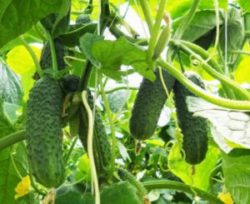
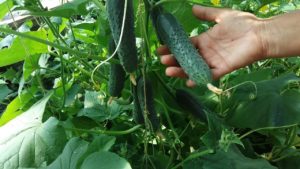

 (2 ratings, average: 4,50 out of 5)
(2 ratings, average: 4,50 out of 5) CUCUMBERS NEVER GET SICK, I'VE BEEN USING ONLY THIS FOR 40 YEARS! I SHARE A SECRET WITH YOU, CUCUMBERS ARE LIKE THE PICTURE!
CUCUMBERS NEVER GET SICK, I'VE BEEN USING ONLY THIS FOR 40 YEARS! I SHARE A SECRET WITH YOU, CUCUMBERS ARE LIKE THE PICTURE! You can dig a bucket of potatoes from each bush. Do you think these are fairy tales? Watch the video
You can dig a bucket of potatoes from each bush. Do you think these are fairy tales? Watch the video
 How our fellow gardeners work in Korea. There is a lot to learn and just fun to watch.
How our fellow gardeners work in Korea. There is a lot to learn and just fun to watch. Eye trainer. The author claims that with daily viewing, vision is restored. They don't charge money for views.
Eye trainer. The author claims that with daily viewing, vision is restored. They don't charge money for views. A 3-ingredient cake recipe in 30 minutes is better than Napoleon. Simple and very tasty.
A 3-ingredient cake recipe in 30 minutes is better than Napoleon. Simple and very tasty. Therapeutic exercises for cervical osteochondrosis. A complete set of exercises.
Therapeutic exercises for cervical osteochondrosis. A complete set of exercises. Which indoor plants match your zodiac sign?
Which indoor plants match your zodiac sign? What about them? Excursion to German dachas.
What about them? Excursion to German dachas.